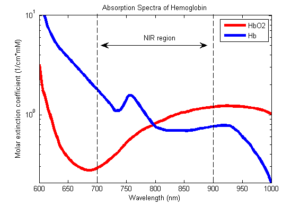Covid-19 resources: what is a pulse oximeter? Why are they malfunctioning?
Pulse oximetry is used to measure the oxygenation level of the blood. It is an easy, non-invasive and painless measure of how well oxygen is moved from your lungs to parts of your body furthest from your heart, like arms and legs. A clip-like device, the probe, is placed on a finger or ear lobe. Nowadays, the modest (about $60, used to be $20 before the pandemic) pulse oximeter is becoming a star. For a healthy person, the probe should read 95 or higher. Surprisingly, people who are sick with Covid-19 seem to have very low readings while seemingly doing still OK. What is going on? To understand you have to look at how the device works.
What does the pulse oximeter measure? It measures light absorption. In normal circumstances, it tells you about the fraction of hemoglobin, the protein in blood that carries oxygen, that is loaded with oxygen. How does it do that? It takes advantage of the difference in the light absorption spectra between hemoglobin loaded with oxygen, and the spectrum of de-oxygenated hemoglobin What you get, after a calculation made by the mini-computer in the device, is an estimate of of arterial pO2

Figure: absorption spectra of oxygenated and de-oxygenated (blue) hemoglobin.
It seems that what the virus that causes Covid-19 affects the body in a strange way so that the oximeter may no longer give a good estimate of arterial pO2
In the future, researchers will find out what changed, why this method no longer gives a approximation of the percentage of blood that is oxygenated. What has changed? Surely not the light absorption properties of hemoglobin. Is there something else in the blood affecting light absorption? Young people (who shouldn’t) have strokes, a blood clot is removed and many more appear. This awful virus, which attacks mainly the respiratory system, also gets in the blood and damages so many different organs.
An oximeter may be able to tell if a person who is sick is affected by Covid-19 rather than a flu virus, because flu does not affect the performance of the pulse oximeter. And remember to get spare batteries, sometimes a device malfunctions because the battery is low!
I have my own humble pulse oximeter at home. I hope I won’t have to use it for anything in the near future, but it is the kind of thing you want to have on hand, together with a thermometer, acetaminophen, band-aids and antibiotic cream.
All over the world, scientists are working hard to design effective and safe vaccines. Other scientists are trying to find effective antivirals and designing new ones. In the meantime, social distancing, washing hands, staying home is what can keep us safe.
Claims on this page have not been evaluated by the FDA and are not intended to diagnose, cure, treat or prevent any disease. Hannah Sivak is NOT a medical doctor, although she is better informed that some people who make health care suggestions on TV. Listen to science, not to quacks.
Update: 12/28/2020
